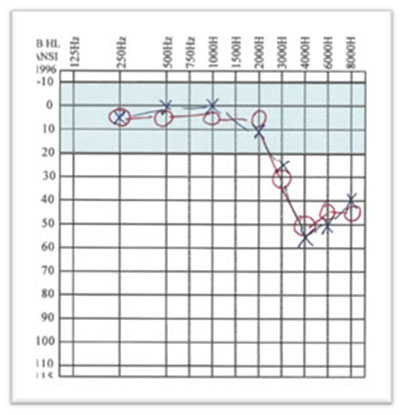Why caring for your hearing is important
Music rehearsals and performances begin with a vital exercise: tuning the instruments.
Tuning is essential to ensure harmony and produce a blend that’s a delight to the ear. While you and your students may perform tuning often in a typical day, you may be unaware that you can also lose the tuning of your most valuable instrument: your hearing.
Most of us don’t fully appreciate the wonders of our hearing.
Normal hearing encompasses an intensity range so great it requires a logarithmic scale to quantify it (the decibel), a frequency range beyond the typical music or speech spectrum (20 – 20,000 Hz), and exquisite temporal analysis and frequency resolution abilities that allow us to perform complex auditory tasks (such as locating sound sources in the spatial plane, understanding speech in background noise, and direct an ensemble by hearing and analyzing the instruments individually and as a blend). Hearing loss affects each of these aspects of hearing, and although there are many causes of hearing loss, the most common is excessive sound exposure (which for simplicity, we call “noise-induced hearing loss” or NIHL).
The most basic measure of hearing is the pure tone threshold; for this test the softest sounds you can hear are plotted for a narrow range of frequencies (those that contribute most to speech understanding: 250 – 8,000 Hz). The audiogram is a plot of pure tone thresholds across frequency, and shows an individual’s hearing sensitivity for quiet sounds.

Figure 1: Hypothetical Audiogram. Frequency is on the X axis and intensity on the Y axis. Red symbols are right ear; blue symbols are left ear.
The shaded region is the normal range. In this example, hearing in both ears is similar (symmetrical), and is normal in the low to mid frequencies (250 – 2000 Hz), dropping to a mild-to-moderate hearing loss in the higher frequencies (3000 – 8000 Hz).
Most hearing loss can’t be corrected medically or surgically (an audiologist can determine the need for medical intervention and will refer to an otolaryngologist as necessary). If the hearing loss warrants it, hearing aids will be recommended to compensate for the loss of audibility for quiet sounds. However, hearing loss is so much more. NIHL damages hearing not only the loudness domain, but it also dulls our exquisite frequency resolution and reduces our temporal analysis abilities. This is why making sounds louder doesn’t necessarily make them clearer, and why hearing aids can’t restore normal auditory abilities to those with hearing loss. Understanding how to preserve the exquisite tuning of our ears and protect them from damage is fundamental to anyone who wants to enjoy music to the fullest degree possible throughout their lifetime.
In over a decade of attending the Midwest Band Clinic, Etymotic Research president Mead Killion, Ph.D., has rarely encountered a band director who didn’t have some degree of hearing loss. Hearing loss was often thought to be an inevitable consequence of the job: high sound levels experienced in directing a roomful of music students for hours each day, over many years.
However, NIHL is preventable, and the good news is that many music instructors “and their students are embracing the knowledge and tools that enable them to maintain their ears’ fine tuning so they can fully appreciate and enjoy music, not only now, but for decades to come.
Awareness of the risk of NIHL isn’t enough; most of us want answers to specific questions, such as:
- What happens to our ears when we have a noise overdose?
- Is noise-induced hearing loss temporary or permanent?
- What’s that ringing sound I hear at the end of a long, loud day?
- Do ears recover after a noise exposure?
For answers to these questions and more, see Part 2, “If only we’d known: consequences of over-exposure to high sound levels.”
Patricia A. Johnson, Au.D.
Etymotic Research, Inc.
61 Martin Lane
Elk Grove Village, IL 60007
888-389-6684
p_johnson@etymotic.com
www.etymotic.com


